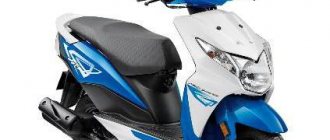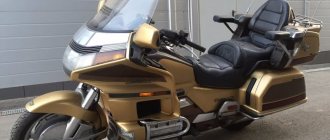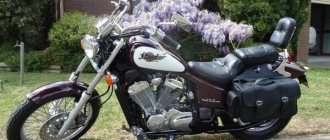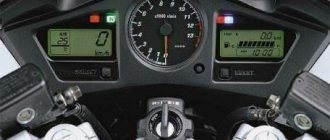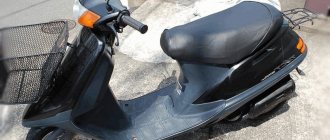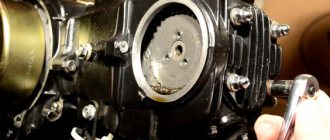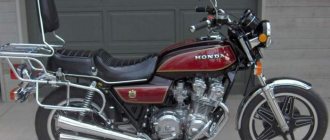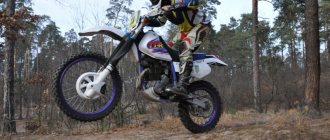The mid-sized cruiser Honda Shadow 1100 is a true road veteran. This model was first introduced to the general public in the mid-80s, and since then it has undergone many changes, becoming better from generation to generation. All over the world there are numerous clubs for fans of this model, the popularity of which has not faded to this day, despite the fact that the famous Japanese “Shadow” has not been produced for a long time, and there are many reasons for this.
Model history
- The first generation VT 1100 rolled off production lines in 1985, becoming an alternative for those bikers who lacked the capabilities of the VT 600 (aka Honda Steed 600 for the US and Canadian markets). In those years, they were not so zealous about the environment, so the bike’s engine was not strangled, and the engine of the first Honda Shadow 1100 produced an impressive 78 hp.
- In 1987, this cruiser was updated for the first time, receiving the factory name VT1100C and a completely retuned engine that produced less power - 67 hp. However, thanks to this change, Honda engineers managed to significantly improve traction in the lower and middle speed ranges.
- The basic version was produced until the end of 1996, but already in 1995 a modification of the Honda Shadow 1100 ACE, developed specifically for the US market, was released. Its distinctive features were spoked wheels, deeper fenders, more vibrations, so beloved by Americans (due to the use of one connecting rod rack versus two on the “classic” engine), a disc brake on the rear wheel and an engine power of 53 hp. She lasted on the assembly line for 4 years. From 1998 to 2001, there was also a Tourer modification, which was distinguished by a pre-installed body kit - side cases, a windshield, alloy wheels instead of spoked ones, a different exhaust and a different wheel size.
- The Honda Shadow 1100 Spirit was produced from 1997 to 2007, becoming perhaps the most popular cruiser of the entire famous line. Externally, the Spirit was practically no different from the base model, but it had a 15.8-liter gas tank instead of 13-liter and a 5-speed transmission instead of the previous 4-speed. It is this motorcycle that can often be seen on the roads, since this version of the VT 1100 has technical characteristics that fully correspond to the price of a used bike on the secondary market.
- At the turn of the millennium, from 1998 to 2000, there was also the Honda Shadow 1100 Aero, which was essentially a version of the ACE with a different exhaust and a larger headlight.
- And finally, the second most popular modification after Spirit is the Honda Shadow 1100 Saber, for which the Japanese designers took the ACE, which they equipped with a full-power engine from the Spirit. This model was produced from 2007 to 2007, after which all models of the VT series were discontinued, having gained a reliable foothold in the world market and giving way to fresh reinforcements in the form of the Honda VTX 1300.
Modifications
It was from version 1100 that 3-5 modifications began to be launched in the line. The liter engine had:
- VT1100C Shadow - basic version. Production began with it. 4-speed, 13 liter tank, 2 exhaust pipes along the right side of the motorcycle. Assembly completed in 1996.
- VT1100C2 ACE — the abbreviation at the end indicates that the model is for the American market. Elongated fenders, wide wheels, the appearance of a disc brake on the rear wheel, and, curiously, 1 connecting rod rack on the crankshaft to increase vibrations. Starts in 1995, ends in 1999.
Honda VT1100C2 ACE – stands for American Classic Edition.
- VT1100C Spirit - in 1997 it took the place of the previous one on the assembly line. They are similar in appearance, but there are also differences. The fuel tank has been increased to 15.8, as well as a 5-speed gearbox. Production of the modification ends with the closure of the model.
- VT1100T ACE Tourer is an unusual touring development, an offshoot from the main one. Branded plastic panniers, windshield, exhaust cans are moved to both sides, and the wheels are also changed. Started in 1998, closed in 2001.
- VT1100C3 Aero - the ACE modification taken as a basis has enlarged wings, changed the headlight and exhaust. Production began in 1998, closed in 2002.
- VT1100C2 Saber - the same reworking of the ACE version, but with a different engine - a slightly updated version from Spirit. The tank and gearbox also come from it. New alloy wheels. Assembly began in 2000 and ended when the model was closed.
The Tourer version appeared only once, in the VT1100. In other models of the Shadow line, this option was no longer available.
VT1100T ACE Tourer – stock windshield and spacious panniers.
and competitors
The model was not left without competitors.
- Yamaha offered two at once - the XV 1100 Virago and the XVS 1100 Drag Star. It’s interesting that the developers themselves call the second a logical continuation of the first.
- Kawasaki has introduced the VN1500. Aka Vulcan 88, aka VN-15. It is interesting that his model has a one and a half liter engine.
- Suzuki did not participate, but its development includes the Intruder 1500, which is often compared to the models presented by competitors above.
Reasons for popularity
These days, this bike is still very widely represented on the secondary market in Russia and other countries. The most often found on sale is the Honda Shadow 1100 Spirit, probably because there were so many of these motorcycles produced. Honda Shadow 1100 Saber is also often found, but old first-generation Shadows in a “living” state are problematic to find - age, alas, does not spare anyone. However, there is no point in chasing this modification specifically - the more recent Spirit, ACE and Saber easily outperform their ancestor in all respects - the Honda Shadow 1100 has very good technical characteristics even by modern standards.
The reliability of Honda motorcycles has already become a proverb, and absolutely deservedly so. Even 20-year-old Honda Shadow 1100s often feel great and look no less good, if, of course, they were in caring hands. But if the Honda did not spend the winter in a snowdrift under the window, and its previous owner did not reduce all maintenance to changing the engine oil, you won’t have to worry about its technical condition.
Bottom line
The Honda Shadow 1100 motorcycle is a worthy representative of its class. It can easily be classified as a legend, and random motorcycles do not fall into such a list. The appearance of the bike is very calm and classic (for its class), all characteristics are balanced and sufficient. Add here Japanese reliability and the relatively low cost of the model on the secondary market, and you get a very, very worthy option for cruiser lovers. On such a motorcycle you can travel around the entire planet, or you can just ride in your own city and beyond on weekends.
The motorcycle is loved and respected by bikers all over the world. This is a classic that is timeless. A simple hard worker in a stylish look. He will never let you down and will always deliver to your destination. This is a model of those years when motorcycles were alive, and not stuffed with various modern electronics and a variety of computer systems. This bike can be repaired in a garage environment on your lap. A model for those who appreciate the old school. A worthy copy for the garage of the owner who understands real motorcycles.
There is an opinion among motorcycle enthusiasts that one needs to grow into such a motorcycle from the point of view of motorcycle “philosophy”. There is some truth in this phrase, because a cruiser is almost never chosen as the first motorcycle, but very often experienced motorcyclists choose cruisers and never change class.
VT1100 Specifications
Any Shadow, regardless of modification, is a strong average in all respects, be it a Honda Shadow 1100 Spirit, Saber or ACE. The liter engine has truly “locomotive” thrust at low speeds, which, coupled with a modest weight by cruiser class standards (about 250-260 kg), makes the bike very dynamic. It accelerates very vigorously, losing its enthusiasm and noticeably giving up when it reaches 120-130 km/h on the speedometer. The maximum speed for a motorcycle is about 180 km/h, but it depends on the condition of the particular instance and other factors. But the Honda Shadow 1100 has perfectly balanced technical characteristics - this cruiser is equally well suited for long trips and for daily driving around the city.
At the same time, the “Shadow” engine willingly consumes AI-92, with properly configured carburetors it fits into 6 liters of fuel per 100 km at speeds of 120-130 km/h. At higher speeds, unpleasant parasitic vibrations appear, especially in the ACE and Aero versions. Fortunately, the Honda Shadow 1100 Spirit and Saber models vibrate noticeably less. The volume of the gas tank is enough for 200-250 kilometers of driving without refueling, but the exact value depends on the selected speed, fuel quality, condition of the motorcycle and its load. If you have the opportunity to personally ask the owners of this model, so much the better.
Motorcycle Honda VT 1100C Shadow Spirit 2007 review
The Honda Shadow 1100 (Honda VT 1100) cruiser model was first introduced in 1987 and is aimed primarily at the US market. Back then it was a classic cruiser with a big front wheel, dual exhaust on the right side and a 4-speed transmission. The model was produced in this form until 1990, after which its production was discontinued for a year. In 1992, the Honda Shadow 1100 re-entered the market, slightly updated - having received a 5-speed gearbox and a 17′ front wheel. Honda subsequently introduced a number of modifications to the Shadow 1100, updating the model until 2007.
The main feature of the Honda Shadow 1100 is a 2-cylinder V-twin engine with liquid cooling, producing from 50 to 63 hp. power and 84-95 Nm of torque, depending on the version of the motorcycle. The model has a 5-speed gearbox, a classic steel frame, simple suspension in the form of a telescopic fork and a double shock absorber at the rear, as well as a cardan drive.
Main modifications of the Honda Shadow 1100:
- Honda Shadow 1100 - regular version, produced from 1987 to 1995. It is distinguished by wheels on alloy discs and short fenders.
- Honda Shadow 1100 Spirit was the name of the regular version of the motorcycle since 1997 on the US market. The version receives more chrome elements. The engine produces 60 hp.
- Honda Shadow 1100 Classic is the classic version for all markets except the USA. It features spoked wheels and extended fenders. It replaced the regular version of the motorcycle in 1995 (except in the USA).
- Honda Shadow 1100 ACE (American Classic Edition) - the version is similar to the Classic, but has a crankshaft with one connecting rod (to increase vibrations) and a power of 50 hp.
- Honda Shadow 1100 ACE Tourer - the version is similar to the ACE, but has alloy wheels, a 2-into-1 exhaust system, a windshield, side cases and a 60 hp engine. from the Spirit version.
- Honda Shadow 1100 Aero - The version is similar to the ACE, but has longer retro-style fenders, a larger headlight and a 2-into-1 exhaust.
- Honda Shadow 1100 Saber - the version is similar to the ACE, but has alloy wheels, Showa suspension, the engine from the Spirit version and a rear disc brake.
The latest modification of the model was the Saber version, which was produced until 2007 - even despite the fact that the Honda VTX 1300 appeared in 2001. In general, the Honda Shadow 1100 can be called an extremely successful model, which is confirmed by the high popularity of this motorcycle in the USA, where Harley-Davidson reigns supreme.
However, even this did not prevent Honda from conquering a significant part of the market and providing worthy competition to the then flagships. Model range of the Honda Shadow series:
- Honda Shadow 400
- Honda Shadow 600
- Honda Shadow 750
- Honda Shadow 1100
Average fuel consumption on the Honda Shadow 1100 ranges from 5.3 liters to 9.6 liters per 100 km. The exact value depends on your riding style. The price for a Honda Shadow 1100 in good condition, without mileage in the Russian Federation, is $3,500. The cost of models with mileage in the Russian Federation starts from 160,000 rubles.
- 1987 - official start of production and sales of the Honda Shadow 1100. The model was also called the Honda VT 1100 C.
- 1991 - the model is not officially released.
- 1992 - Honda Shadow 1100 gets a 5-speed gearbox and a 17′ front wheel.
- 1995 is the last year of production of the motorcycle in the regular version (Honda Shadow 1100). The model is being replaced by the Classic modification in all markets except the US market. In the USA, in parallel with the regular version, the ACE modification appears. The model is also called Honda VT 1100 C2.
- 1997 - the regular version of the motorcycle (for the US market) is called Spirit. In the same year, the ACE Tourer modification appeared.
- 1998 - appearance of the Aero modification. The model is also called Honda VT 1100 C3.
- 2000 - appearance of the Saber modification. The model is also called Honda VT 1100 Saber.
- 2007 is the last year of release of the Saber modification.
Knowing the Americans' passion for V-shaped engines, Honda engineers designed a family of V4 engines, which appeared in the fall of 1981 in the chassis of the classic Saber motorcycles and the choppered Magna.
And just a year later they rolled out a family of Honda Shadow cruisers (translated from English as “shadow”) with the coveted 2-cylinder engine. True, the Japanese did not immediately understand the mysterious American soul, and the new products turned out to be simply “high-tech” by the standards of that time: with liquid cooling (disguised by the abundant fins of the cylinders), 3-valve heads, 6-speed gearboxes, cast wheels and a cardan main gear. At first, the Japanese produced “twos” only in 500 and 750 cm3 formats, believing that lovers of large cubic capacity would be quite satisfied with the 4-cylinder 1100 cc Magna. No matter how it is! The Americans considered its 120-horsepower engine more suitable for sports bikes and demanded: “Give me something Harley-like!” The specialists from Honda again did not object. The Honda Shadow 1100 version was launched in 1985, and its assembly was organized at a plant in the USA: at that time there were serious duties on the import of motorcycles with engines with a displacement of more than 700 cm3 (adopted to save Harley-Davidson, which was losing its position in the market). Technically, the car retained the features of its younger sisters: liquid cooling, 3-valve cylinder heads, cardan transmission. And only much later the time came for small cubic capacity V-Twins, which were no longer supplied to America (well, they don’t respect small things in the country!). In 1993, the 250 cc V25 Magna, intended only for the Japanese market, debuted (its copy, by the way, is produced by several Chinese and Taiwanese factories), and in 1998, the Honda Shadow 125, which instantly became a bestseller on the European market. But technically, these cars are very different from motorcycles of medium and large cubic capacity, and we will not touch on them in this review. Many motorcycles from Honda can be described as “smooth”. Without obvious flaws, without significant shortcomings, without particularly outstanding advantages. The Honda Shadow motorcycle is just that. There aren’t enough stars in the sky, but there aren’t enough stars in the gray middle peasants either. Everything is at an excellent level, everything is well designed, thought out and verified. Everything is reliable, clear, smooth and calm. This motorcycle was initially aimed at the US market and, in response to market requirements, received many modifications, sometimes significantly different technically. So, for example, in the Honda Shadow ACE version, the connecting rods are located on one journal - consumers wanted the engine to be “vibrant”, like a Harley-Davidson. Another feature is that with each new version the engine became more and more “sluggish” at the “top” and with more and more “tractor” traction at low speeds. Generally speaking, the development of the Honda VT 1100 Shadow series is a clear example of how the Japanese (although the device was produced in the USA, was developed on the islands) understood one simple idea: the more a cruiser looks like a Harley, the better it sells. This model, VT 1100 C2, is interesting for us, first of all, because quite a few of them were sold in Russia not only as second-hand goods, but also new, through an official importer. All qualities of the engine are characterized by two words - comfort and reliability. The motor is made without balancer shafts, but the design of the crankshaft and the shape of its flywheels are such that the vibrations of the motor are minimal. The power supply uses a constant vacuum carburetor with an accelerator pump, which provides a very smooth engine with good dynamic characteristics. Although, of course, “thanks to” the depowering, the “tops” of the motorcycle, if not conditional, are far from impressive. But there is also no doubt about the eternal youth of the engine, unless, of course, it was ruined by a “teapot” who forgot to change the oil and filters. What's on the other side of the scale? Perhaps it’s just the difficulty of maintenance - the layout is too dense. To get to some components, you will have to almost disassemble half the motorcycle. But this is a common problem with many cars with a V-shaped engine and a small cylinder camber angle. She is simply unkillable. A mileage of 100,000 km does not show any significant wear. The strength of the cardan transmission is simply absolute - if on other motorcycles with cardan transmission there are cases where the couplings break, then on this one no such collisions were noticed. The classic duplex design has quite decent characteristics and works great in any mode available to the motorcycle. Due to the large number of versions of the device and its enormous popularity around the world, the choice of various tuning and styling tricks is simply huge. The rear suspension is adjustable by spring preload. In general, the suspensions are comfortable, but at the same time quite energy-intensive, not prone to breakdowns and allowing for fairly good control of the motorcycle on surfaces of varying quality. The performance of the front fork under hard braking is simply excellent - not the slightest hint of twisting. They fully correspond to the energy and speed capabilities of the motorcycle. No tuning required. The rear may seem a little harsh. As already noted, the motorcycle turned out to be so convenient and comfortable that some modifications were specially created with an eye to reducing comfort! It is quite difficult to list all the modifications of the motorcycle throughout its history, so we will only note the one that is aimed strictly at the US market. This modification bears the abbreviation ACE in its designation and is distinguished, among other things, by three-valve cylinder heads. In Europe, the “successor” is also known - the C3, which was distinguished by a more “Indian” body kit, the style of which Honda itself called nothing less than art deco. The predecessor of this model, “simply” the Honda VT1100C Shadow, is still one of the most common choppers/cruisers on the market.
Go to the entire range of Honda motorcycles, on this page you can find Honda VT 1100C Shadow Spirit motorcycles from other years of production and information about them
Tuning VT 1100
Most Honda VT 1100 Shadow Aero, Spirit and others are modified by their owners based on their needs - some prefer a “hooligan” urban style, while others turn their bike into a real kilometer eater. Fortunately, a lot of tuning for this model is sold - saddlebags, windshields, seats, chrome packages, lighting optics, levers, reinforced brakes... But it is worth noting that, thanks to a fairly simple design, the process of customizing this steel horse “for yourself” is not particularly difficult labor.
Reviews about VT 1100
Most owners of the Honda Shadow 1100 agree on one thing - this is a really good motorcycle, reliable and certainly worth the money. We collected reviews from real owners of this model on the Internet.
I bought a slightly battered Shadovka two years ago, it had a slight slip after an accident, mainly cosmetics were damaged, plus there were dents on the gas tank. But I got the motorcycle for cheap, and after repainting and restoring its appearance, it still rides, and hasn’t given me any surprises yet, although I’ve personally had almost 20,000 miles on it. The motorcycle is excellent; anyone who doesn’t believe it can read reviews from other owners of the Honda Shadow 1100. Vladimir, Moscow, Honda Shadow 1100 Aero '1999.
When I sold the old Steed 400, the question arose about a new moped, more powerful, but money was tight. In the end, I took the old VT1100C, with gearbox 4, put my hands on it in the off-season, then drove for three years until I sold it and bought a VTX 1800. In general, The Honda Shadow 1100 has pleasant technical characteristics, but I wanted more adrenaline. Sergey, Vladivostok, VT1100C '1988.
I am a happy and satisfied owner of an Aero from the last year of production. In six years, the motor ran almost fifty thousand kilometers, there were no serious incidents. Once I over-braked before a traffic light and lay down on my side, eventually hitting the tank and breaking the right footrest bracket. The tank was pulled out with a reverse hammer, the bracket was welded. In general, the front brakes are good, but the rear brakes are a C at best, still a drum. Consumption is from 5 liters if you use 95-grade gasoline, but I only use it on long-distance trips so that I have more range, otherwise I use 92-grade gasoline. During all this time, I changed the oil seals with anthers on the fork, the carburetor pipes (they dried out along the way and cracked), the steering column bearings (iron also does not last forever) and the rear gearbox assembly along with the cardan. The gearbox was ruined by itself, through its own fault - it did not tighten the drain bolt tightly, as a result the oil was gone and it ran dry, the cardan licked the splines on the shaft, the wheel began to slip idle. Everything else is normal, the total mileage is already under 100 thousand, the flight is normal. Sergey, They vibrate noticeably less, Honda Shadow 1100 Aero '2002.
I purposefully searched for a Honda Shadow 1100 Aero, ended up buying an ACE, and I don’t regret anything. I don’t know who says that his engine is strangled, as for me it’s normal, and there are also sane brakes at the rear instead of a stupid drum. Marat, Saratov, Honda Shadow 1100 Aero '2000.
Main competitors:
- Yamaha XVS 1100 Drag Star (aka V-Star 1100) for the US market. This bike is so similar in performance and design features to the Shadow 1100 that choosing between them comes down to a simple question - which of the two bikes do you prefer.
- Kawasaki VN1500 Vulcan . A heavier, structurally archaic, but proven cruiser over the years. It has an excellent range without refueling, and is similar in dynamics to the VT1100, but is inferior to it in maneuverability.
- Suzuki VS1400 Intruder . An old-fashioned motorcycle that looks more like a chopper than a cruiser. The older versions (the first two generations) are distinguished by very high power, the more recent ones, produced under the name Boulevard S83, have already been “strangled” for the sake of environmental standards.
To take or not to take—that is the question!
So, you're in the market for a mid-priced, mid-capacity cruiser, and you're obviously thinking about buying a used VT1100, judging by the fact that you're reading this article. Good idea - it's a really great bike! Of course, you can also come across a copy that is in a sad state - after all, old bikes usually passed through many hands, and not all of these hands were caring. But due to the fact that there were a lot of “Shadows” produced, finding a motorcycle in decent condition is not difficult. The Honda Shadow 1100 has enough technical characteristics to become not only a faithful steel horse for every day, but also a real “adrenaline squeezer”. At the same time, maintaining the bike will not be too costly - consumables and spare parts are no more expensive than for any other Japanese motorcycle, give or take.
Coping with the VT1100 will not be difficult even for the most experienced motorcyclist. The weight of the bike is modest - the Honda Shadow 1100 Spirit, for example, weighs only about two and a half centners, which, coupled with a low center of gravity, makes the motorcycle subjectively quite light. And if you compare it with macro cruisers like the VTX 1800 or Kawasaki VN2000 Vulcan, the difference becomes more than obvious. The seat height is also low, and even the longest-legged biker will feel confident enough behind the wheel of the VT1100.
Specifications
| Maximum engine power: | 78 hp (58 kW) at 6000 rpm – VT1100C (1985-1986); 67 hp (49 kW) at 5500 rpm – VT1100C (1987-2007); 53 hp (39 kW) – VT1100C2, VT1100T HP |
| Torque: | 101 Nm (10.1 kgm) at 4500 rpm – VT1100C (1985-1986); 91 Nm (9.27 kgm) at 2700 rpm – VT1100C (1987-2007); 88 Nm (8.9 kgm) at 2700 rpm – VT1100C2, VT1100T Nm |
| Working volume: | 1099 cm3 |
| Motor type (cylinder arrangement, number of strokes): | 2-cylinder, 4-stroke, V-shaped |
| Number of cylinders: | 2 |
| Number of valves: | |
| Intake type (Injector / Carburetor): | |
| Bore and stroke: | |
| Starting system (Electric starter, kick starter): | |
| Maximum speed in km/h: | 172 km/h |
| Cooling system: | Liquid |
| Transmission (gearbox): | 5-speed – VT1100C (1985-1986), VT1100C (1997-2007), VT1100C2, VT1100C3, VT1100T; 4-speed - VT1100C (1987-1996) |
| Clutch (Dry / Wet): | |
| Drive unit: | Cardan |
| Frame: | Steel |
| Chassis | |
| Suspension (front/rear travel): | |
| Brakes (Front/Rear): | |
| Wheels / Tires / Rubber: | |
| Dimensions and weight | |
| Dimensions (Length / Width): | |
| Seat height: | |
| Ground clearance: | |
| Curb weight: | |
| Wheelbase: | 610 mm – VT1100C (1985-1986); 1651 mm – VT1100C (1987-1996); 1650 mm – VT1100C (1997-2007), VT1100C2; 1655 mm – VT1100T mm |
| Weight: | 245 kg – VT1100C (1985-1986); 242 kg – VT1100C (1987-1996); 251 kg – VT1100C (1997-2007); 260 kg – VT1100C2; 284 kg – VT1100T kg |
| Fuel tank capacity: | 15.0 l – VT1100C (1985-1986); 13.0 l – VT1100C (1987-1996); 15.8 l – VT1100C (1997-2007), VT1100C2, VT1100C3, VT1100T l. |
| Battery capacity: | |
| Year of release: | |
| Country of Origin: |
Honda VT 1100 Shadow
Brief review of Honda VT 1100 Shadow
The Honda VT 1100 Shadow, which exists in various versions, was produced for twenty years and was intended primarily for North American countries. However, this motorcycle is also very popular in Russia, and in general the model can be called very successful. Having gone on sale in the late 80s of the last century, the Shadow 1100 quickly gained popularity and recognition among many motorcyclists.
Unlike the younger model in the line, the Honda Shadow 750, this motorcycle has always been equipped with only a cardan drive. There are many different modifications of this model, but they all share the same V-twin liquid-cooled engine, steel frame and simple suspension with two shock absorbers at the rear.
List of modifications of the Honda VT 1100 Shadow
- Honda VT 1100 Shadow - standard version with short fenders and alloy wheels, produced from 1987 to 1995
- Honda VT 1100 Shadow Spirit - a regular version updated in 1997 for the US market, which received minor cosmetic changes and minor changes to the engine
- Honda VT 1100 Shadow Classic - version with long fenders and spoked wheels. Not officially sold in the US
- Honda VT 1100 Shadow ACE - similar to the Classic, but with changes to the engine that added vibration to the motorcycle. Power reduced to 50 hp. The motorcycle was officially sold only in the USA
- Honda VT 1100 Shadow ACE Tourer - similar to ACE, but with alloy wheels, 2-in-1 exhaust, pre-installed saddlebags and windshield, as well as a 60-horsepower engine from the Shadow Spirit version
- Honda VT 1100 Shadow Aero - similar to ACE, but with deep fenders and 2-into-1 exhaust
- Honda VT 1100 Shadow Saber - similar to ACE, but with rear disc brake, 60-horsepower engine from Shadow Spirit, alloy wheels and improved Showa suspension
Similar motorcycles:
- Yamaha XV 1100 Virago
- Yamaha XVS 1100 Drag Star (V-Star 1100)
Technical characteristics of Honda Shadow 1100
- Years of production: 1987-2007
- Class: cruiser
- Frame: steel
- Engine: 4-stroke, 2-cylinder, V-shaped
- Engine capacity, cubic meters see: 1099
- Cooling: liquid
- Valves per cylinder: 3
- Fuel supply: two carburetors
- Power: from 50 to 67 hp. at 5500 rpm depending on modification
- Torque: from 84 to 95 Nm at 2500 rpm depending on version
- Maximum speed, km/h: 180
- Acceleration from 0 to 100 km/h: ~6 seconds
- Transmission: 5-speed (4-speed until 1992)
- Wheel drive: cardan
- Front tire: depends on version
- Rear tire: 170/80-15
- Front brakes: 1 disc 336 mm, 2-piston caliper
- Rear brakes: drum (1 disc 276 mm for Saber modification)
- Front suspension: telescopic fork
- Rear Suspension: Dual shock absorbers with preload adjustment
- Gas tank volume, liters: 13 to 19 depending on modification
- Fuel consumption at 110 km/h, liters: ~5.5
- Dry weight, kg: ~250 (depending on modification)
Pros and advantages of Honda Shadow 1100
- Convenient Maintenance
- Smooth and confident traction even from low revs
- Huge engine life and high reliability
Pros and cons of the Honda Shadow 1100
- Not everyone likes the vibrations of the ACE versions; in addition, they often cause threaded connections to become loose
- Weak brakes on all versions except Shadow 1100 Saber
- Weak engine on ACE versions
- Archaic 4-speed gearbox on early models (late 80s) Poor headlight light

